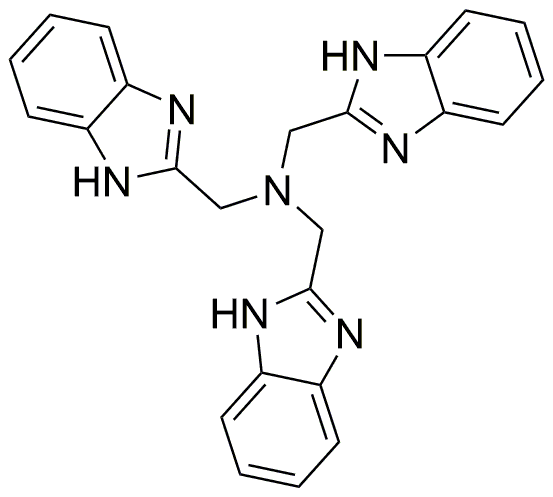Tris(2-benzimidazolylmethyl)amine is widely utilized in research focused on:
- Catalysis: This compound serves as an effective ligand in various catalytic processes, enhancing reaction rates and selectivity in organic synthesis.
- Coordination Chemistry: It forms stable complexes with transition metals, making it valuable in the development of new materials and in the study of metal-ligand interactions.
- Biological Applications: Its unique structure allows it to interact with biological systems, potentially leading to the development of novel pharmaceuticals targeting specific enzymes or receptors.
- Fluorescent Probes: The compound can be used to create fluorescent probes for biological imaging, aiding researchers in visualizing cellular processes in real-time.
- Environmental Chemistry: It has applications in the removal of heavy metals from wastewater, showcasing its potential in environmental remediation efforts.
General Information
Properties
Safety and Regulations
Applications
Tris(2-benzimidazolylmethyl)amine is widely utilized in research focused on:
- Catalysis: This compound serves as an effective ligand in various catalytic processes, enhancing reaction rates and selectivity in organic synthesis.
- Coordination Chemistry: It forms stable complexes with transition metals, making it valuable in the development of new materials and in the study of metal-ligand interactions.
- Biological Applications: Its unique structure allows it to interact with biological systems, potentially leading to the development of novel pharmaceuticals targeting specific enzymes or receptors.
- Fluorescent Probes: The compound can be used to create fluorescent probes for biological imaging, aiding researchers in visualizing cellular processes in real-time.
- Environmental Chemistry: It has applications in the removal of heavy metals from wastewater, showcasing its potential in environmental remediation efforts.
Documents
Safety Data Sheets (SDS)
The SDS provides comprehensive safety information on handling, storage, and disposal of the product.
Product Specification (PS)
The PS provides a comprehensive breakdown of the product’s properties, including chemical composition, physical state, purity, and storage requirements. It also details acceptable quality ranges and the product's intended applications.
Certificates of Analysis (COA)
Search for Certificates of Analysis (COA) by entering the products Lot Number. Lot and Batch Numbers can be found on a product’s label following the words ‘Lot’ or ‘Batch’.
*Catalog Number
*Lot Number
Certificates Of Origin (COO)
This COO confirms the country where the product was manufactured, and also details the materials and components used in it and whether it is derived from natural, synthetic, or other specific sources. This certificate may be required for customs, trade, and regulatory compliance.
*Catalog Number
*Lot Number
Safety Data Sheets (SDS)
The SDS provides comprehensive safety information on handling, storage, and disposal of the product.
DownloadProduct Specification (PS)
The PS provides a comprehensive breakdown of the product’s properties, including chemical composition, physical state, purity, and storage requirements. It also details acceptable quality ranges and the product's intended applications.
DownloadCertificates of Analysis (COA)
Search for Certificates of Analysis (COA) by entering the products Lot Number. Lot and Batch Numbers can be found on a product’s label following the words ‘Lot’ or ‘Batch’.
*Catalog Number
*Lot Number
Certificates Of Origin (COO)
This COO confirms the country where the product was manufactured, and also details the materials and components used in it and whether it is derived from natural, synthetic, or other specific sources. This certificate may be required for customs, trade, and regulatory compliance.


